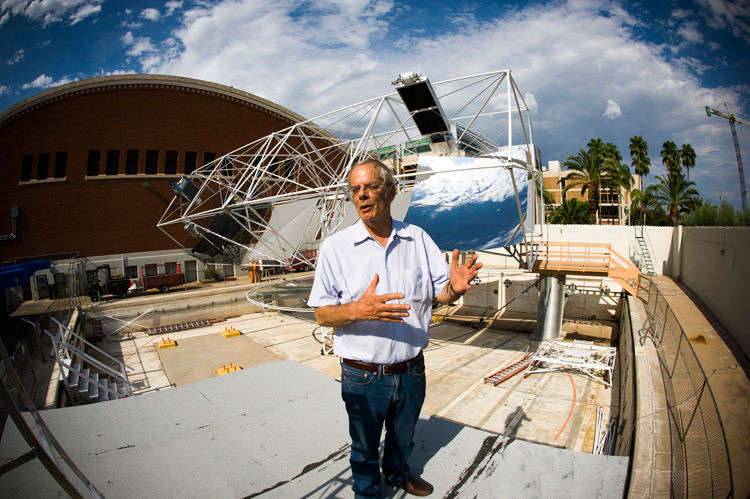This month is the one-year anniversary of the launching if Aeon, the digital magazine that has quickly become the best producer of essays I can find in print or online. Congratulations to Paul and Brigid Hains, who founded the publication, and to all their contributors.
From “Catching the Star,” Lee Billings’ new Aeon essay about astrophysicist Roger Angel, who wants to transform the American Southwest, which is getting closer to dying of thirst, into one of Earth’s chief solar-power stations:
In the first decade of this new century, Angel began to shift his focus from planets around other stars to the planet that we live on, the planet that was growing parched and crowded before his eyes. He has spent years devising a three-decade plan to build and launch 16 trillion tiny, autonomous spacecraft to form a sunshade to cool the Earth to pre-industrial average temperatures, thus counteracting anthropogenic greenhouse heating. The associated expenses would amount to some $5 trillion, although Angel hastens to point out that this would constitute less than one per cent of the world’s gross domestic product for the project’s duration — a bargain compared with the much higher projected costs of allowing global warming to proceed unabated.
No one could find technical flaws with Angel’s audacious plan: the physics was eminently feasible. It was also meticulous. Angel had considered practically every relevant physical variable and technological scenario. Even so, he considered it little more than ‘a Band-Aid’, something that could buy perhaps a century of cooler temperatures. More sustainable long-term adaptations would be needed to deal with the recent spike in greenhouse gases, which promise to linger in the atmosphere for tens or hundreds of thousands of years.
“The sunshade may seem like mad science,” he quips from time to time, “but the fact is, we live upon a mad world.” Not mad enough, however. Not yet. Few would seriously contemplate building anything like Angel’s sunshade until catastrophic warming and sea-level rises are already well under way, and by then, it may be too late. Angel himself prefers that it never be built at all. He believes that cutting carbon emissions would be considerably cheaper in the long run.
To that end, Angel has been working on a new project since 2008, an effort less ambitious than blotting out the light of the sun but audacious enough. He wants to make grid-scale solar power that costs about a dollar per watt — as cheap as or cheaper than electricity from burning coal or other fossil fuels. Moreover, he thinks he has found how to do it, and has even formed a company, REhnu, to gather capital investment and develop the necessary technology.
In years to come, if Angel has his way, his proprietary system of gleaming mirrors and flashing lenses will transform the American southwest and other sun-drenched regions into the 21st-century powerhouses of the globe, driving markets to leave all the world’s remaining coal in the ground. He has attracted several research grants from government agencies, as well as a considerable number of backers from the upper echelons of US astronomy and energy research who, having seen Angel build the Mirror Lab from nothing, prefer to bet with rather than against him.•

